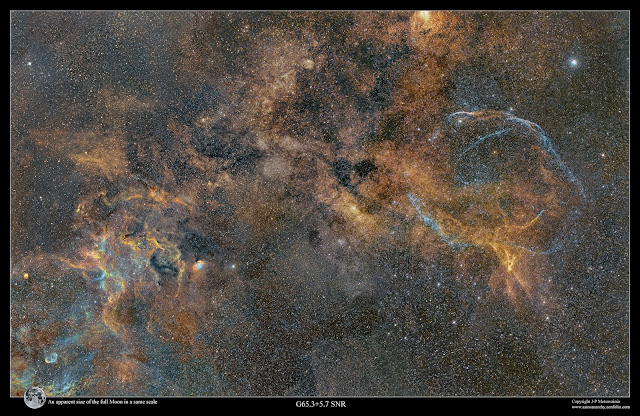COPYRIGHT, PLEASE NOTE
Tuesday, December 15, 2020
Cygnus project, ten years and 500 hours, the grande finale!
Total exposure time is way over 600 hours shot between 2010 and 2020. Some areas of this mosaic panorama required more exposure time than others. There are two large supernova remnants in this mosaic. both are large, diffused and very dim. I have used about 150 hours of exposures for them alone! There are hardly any deep and large enough photos around showing them well.
I have started this imaging project back at 2010. My aim was make a highish resolution mosaic covering the constellation Cygnus. Work like that takes time and patience, especially since I have worked so, that many of the individual sub mosaics or frames can be published as an individual artworks. Here is a poster format presentation about all of longer focal length images used for this mosaic beside actual panels, https://astroanarchy.blogspot.com/2018/11/treasures-of-swan.html
As a result I have now a huge 37 panel (And 58 long focal length sub-panel) mosaic panorama covering 28 x 18 degrees of sky. I have collected photons way over 500 hours during past ten years for this photo. The full size mosaic image has a size of about 25.000 x 15.000 pixels.
A photo of five million stars*
Great Mosaic of Cygnus (2010-2020)
28x18 degrees, 37 + 58 panels and over 600 hours of exposure time
The full size photo is worth to see! (2700 x 1700 pixels)
* I actually counted the stars and in this field of view there are little over five million individual stars
Three supernova remnants, two Wolf Rayet stars and a black hole
Please, click the image for full resolution
You should click the images to see them in full glory, it's worth the effort!
North America and the Pelican Nebula
Original size in mosaic image is 5000 x 2500 pixels
The supernova remnant G65.3+5.7 at top of the mosaic image
A closeup from the supernova remnant G65.3+5.7
The noise is not a noise, just a massive amount of stars
The blog post with technical details can be seen here, https://astroanarchy.blogspot.com/2020/10/the-tulip-nebula-in-cygnus-sh2-101.html
Cirrus of Cygnus
Blog post about this photo, https://astroanarchy.blogspot.com/2020/12/cirrus-of-cygnus-and-supernova-remnant.html
Click for a large image
NOTE I recalculated the total exposure time and it's actually way over 600 hours.
Here is a poster format presentation and a list all of longer focal length images used for this mosaic beside the actual panels, https://astroanarchy.blogspot.com/2018/11/treasures-of-swan.html
Beside three supernova remnants there are two Wolf Rayet stars with outer shell formations. NGC 6888, the Crescent Nebula at center of the image and the WR 134, it can be seen as a blue arch just right from the Crescent Nebula, near the Tulip nebula.
Next to the Tulip Nebula lays a Black hole Cygnus X-1, it's marked in small closeup image of the Tulip Neula at center right in orientation image above.
Constellation Cygnus is an endless source of celestial wonders, both scientifically and aesthetically. For me, as an visual artist, this are of night sky is very inspiring There are endless amount of amazing shapes and structures, I can spend rest of my life just shooting images from this treasury.
A funny anecdote
The answer was; "If you think about the swan, I just pointed out the anatomically correct location"




















7 comments:
simply OMG. amazing. reading your description, I feel the passion, the dedication, looking at your photos you made me excited, reading what you write, you made me excited for the second time. thanks for this.
Matteo M.
Amazing, truly inspirational, and helpful in my next choice
I have been wanting a telescope for fifty years and have just started researching which to buy, a damn big job, being on a pension I have to make every penny count. So far my decision is to get a 12" dobsodian first and then save for a computerised mount, and from seeing your work I think I'm right. Anything smaller would bore me too soon, I say bore rather than leave me unfulfilled because I think no matter the size I would wish for something bigger.
Best wishes and happy Chinese new year (it's just two days ago).
Ronny
Omg, this is beyond words. Truly inspirational!!
Each of the images are so beautiful and intricate that I could sit hours together and admire at them.
The quality is top class!! Thanks for sharing 😊🙏
Thank you. What you have done will inspire many city dwellers to look up to the night sky and admire the beauty of the universe. We use to keep our head down and eye focusing to a small plate of glass on a smart phone!
U did an unbelievable job , i love these amazing pictures, thank you for sharing 🙌🙏🙏🙏🙏🙏🙏
Verdaderamente fabuloso y una gran contribución para la ciencia......y para el arte. Agradecido
You certainly have a tremendous talent and lots of patience to have put all this together. Congratulations on a really great job!!!
Post a Comment